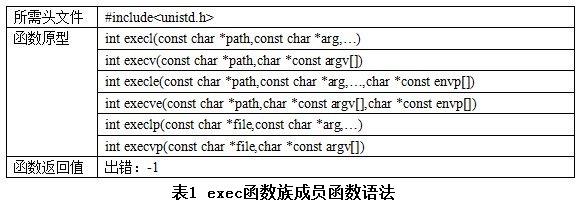本章将讨论 UNIX 系统中的进程创建。UNIX 系统采用了一种非常有趣的创建新进程的方式,即通过一对系统调用:fork()和 exec()。进程还可以通过第三个系统调用 wait(),来等待其创建的子进程执行完成。本章将详细介绍这些接口。
fork()系统调用
系统调用 fork()用于创建新进程。
#include <stdio.h>
#include <stdlib.h>
#include <unistd.h>
int main(int argc, char *argv[])
{
printf("hello world (pid:%d)\n", (int)getpid());
int rc = fork();
if (rc < 0)
{ // fork failed; exit
fprintf(stderr, "fork failed\n");
exit(1);
}
else if (rc == 0)
{ // child (new process)
printf("hello, I am child (pid:%d)\n", (int)getpid());
}
else
{ // parent goes down this path (main)
printf("hello, I am parent of %d (pid:%d)\n",
rc, (int)getpid());
}
return 0;
得到输出如下:
prompt> ./p1
hello world (pid:29146)
hello, I am parent of 29147 (pid:29146)
hello, I am child (pid:29147)
prompt>
当它刚开始运行谁,进程输出一条 hello world 信息,以及自己的进程描述符(process identifier,PID)。该进程的 PID 是 29146。进程调用了 fork()系统调用,这是操作系统提供的创建新进程的方法。新创建的进程几乎与调用进程完全一样,对操作系统来说,这时看起来有两个完全一样的 p1 程序在运行,并都从 fork()系统调用中返回。新创建的进程称为子进程(child),原来的进程称为父进程(parent)。子进程不会从 main()函数开始执行,而是直接从 fork()系统调用返回,就好像是它自己调用了 fork()。
子进程并不是完全拷贝了父进程,所以子进程不会从 main 开始执行,该程序的首行打印并未被子进程执行。它拥有自己的地址空间(即拥有自己的私有内存)、寄存器、程序计数器等。
对于父进程来说,其返回值是子进程的 pid;对于子进程来说,其返回值为 0。
父进程与子进程的执行顺序并不是绝对的,取决于 cpu 的调度算法。
wait()系统调用
有时候父进程需要等待子进程执行完毕,这项任务由 wait()系统调用完成。`
#include <stdio.h>
#include <stdlib.h>
#include <unistd.h>
#include <sys/wait.h>
int main(int argc, char *argv[])
{
printf("hello world (pid:%d)\n", (int)getpid());
int rc = fork();
if (rc < 0)
{ // fork failed; exit
fprintf(stderr, "fork failed\n");
exit(1);
}
else if (rc == 0)
{ // child (new process)
printf("hello, I am child (pid:%d)\n", (int)getpid());
}
else
{ // parent goes down this path (main)
int wc = wait(NULL);
printf("hello, I am parent of %d (wc:%d) (pid:%d)\n",
rc, wc, (int)getpid());
}
return 0;
}
输出结果如下:
prompt> ./p2
hello world (pid:29266)
hello, I am child (pid:29267)
hello, I am parent of 29267 (wc:29267) (pid:29266)
prompt>
本例中,子进程却优先于父进程执行完毕,这是因为父进程调用了wait()操作
当父进程先执行时,会等待子进程结束,才会继续执行
exec()系统调用
exec()这个系统调用可以让子进程执行与父进程不同的程序
#include <stdio.h>
#include <stdlib.h>
#include <unistd.h>
#include <string.h>
#include <sys/wait.h>
int main(int argc, char *argv[])
{
printf("hello world (pid:%d)\n", (int)getpid());
int rc = fork();
if (rc < 0)
{ // fork failed; exit
fprintf(stderr, "fork failed\n");
exit(1);
}
else if (rc == 0)
{ // child (new process)
printf("hello, I am child (pid:%d)\n", (int)getpid());
char *myargs[3];
myargs[0] = strdup("wc"); // program: "wc" (word count)
myargs[1] = strdup("p3.c"); // argument: file to count
myargs[2] = NULL; // marks end of array
execvp(myargs[0], myargs); // runs word count
printf("this shouldn't print out");
}
else
{ // parent goes down this path (main)
int wc = wait(NULL);
printf("hello, I am parent of %d (wc:%d) (pid:%d)\n",
rc, wc, (int)getpid());
}
return 0;
}
输出结果如下:
prompt> ./p3
hello world (pid:29383)
hello, I am child (pid:29384)
29 107 1030 p3.c
hello, I am parent of 29384 (wc:29384) (pid:29383)
prompt>
在这个例子中,子进程调用 execvp()来运行字符计数程序 wc。实际上,它针对源代码文件 p3.c 运行 wc,从而告诉我们该文件有多少行、多少单词,以及多少字节。
给定可执行程序的名称(如 wc)及需要的参数(如 p3.c)后,exec()会从可执行程序中加载代码和静态数据,并用它覆写自己的代码段(以及静态数据),堆、栈及其他内存空间也会被重新初始化。然后操作系统就执行该程序,将参数通过 argv 传递给该进程。因此,它并没有创建新进程,而是直接将当前运行的程序(以前的 p3)替换为不同的运行程序(wc)。子进程执行 exec()之后,几乎就像 p3.c 从未运行过一样。对 exec()的成功调用永远不会返回。如果 exec 函数执行失败, 它会返回失败的信息, 而且进程继续执行后面的代码。
这里简单介绍一下exec()函数族,书上没有给出具体的六个exec函数,但课后练习题需要使用到六个函数,因此简单了解一下。
作用:如果一个进程想执行另一个程序,那么它就可以调用 fork() 函数新建一个进程,然后调用 exec 函数族中的任意一个函数,这样看起来就像通过执行应用程序而产生了一个新进程(这种情况非常普遍)。
下表列出了 exec 函数族的6个成员函数的语法:

下图对这6个函数中的函数名和对应语法做了一个小结,主要指出了函数名中每一位对应所表明的含义,以此表加以记住这6个函数。

资料来源于Linux多任务编程(三)—exec函数族及其基础实验,想看更多相关内容可以点击链接。
为什么这样设计 API
事实证明,这种分离 fork()及 exec()的做法在构建 UNIX shell 的时候非常有用,因为这给了 shell 在 fork 之后 exec 之前运行代码的机会,这些代码可以在运行新程序前改变环境,从而让一系列有趣的功能很容易实现。
shell 也是一个用户程序,它首先显示一个提示符(prompt),然后等待用户输入。你可以向它输入一个命令(一个可执行程序的名称及需要的参数),大多数情况下,shell 可以在文件系统中找到这个可执行程序,调用 fork()创建新进程,并调用 exec()的某个变体来执行这个可执行程序,调用 wait()等待该命令完成。子进程执行结束后,shell 从 wait()返回并再次输出一个提示符,等待用户输入下一条命令。
fork()和 exec()的分离,让 shell 可以方便地实现很多有用的功能。比如:
prompt> wc p3.c > newfile.txt
在上面的例子中,wc 的输出结果被重定向(redirect)到文件 newfile.txt 中(通过 newfile.txt 之前的大于号来指明重定向)。shell 实现结果重定向的方式也很简单,当完成子进程的创建后,shell 在调用 **exec()**之前先关闭了标准输出(standard output),打开了文件 newfile.txt。这样,即将运行的程序 wc 的输出结果就被发送到该文件,而不是打印在屏幕上。
重定向
重定向的工作原理,是基于对操作系统管理文件描述符方式的假设,具体来说,UNIX系统从0开始寻找可以使用的文件描述符。在下面这个例子中,STDOUT_FILENO将成为第一个可用的文件描述符,因此在open()被调用时,得到赋值。然后子进程向标准输出文件描述符的写入,都会被透明地转向新打开的文件而非屏幕。
#include <stdio.h>
#include <stdlib.h>
#include <unistd.h>
#include <string.h>
#include <fcntl.h>
#include <sys/wait.h>
int main(int argc, char *argv[])
{
int rc = fork();
if (rc < 0)
{ // fork failed; exit
fprintf(stderr, "fork failed\n");
exit(1);
}
else if (rc == 0)
{ // child: redirect standard output to a file
close(STDOUT_FILENO);
open("./p4.output", O_CREAT | O_WRONLY | O_TRUNC, S_IRWXU);
// now exec "wc"...
char *myargs[3];
myargs[0] = strdup("wc"); // program: "wc" (word count)
myargs[1] = strdup("p4.c"); // argument: file to count
myargs[2] = NULL; // marks end of array
execvp(myargs[0], myargs); // runs word count
}
else
{ // parent goes down this path (main)
int wc = wait(NULL);
}
return 0;
}
输出结果如下:
prompt> ./p4
prompt> cat p4.output
32 109 846 p4.c
prompt>
首先,当运行p4程序后,好像什么也没有发生。shell只是打印了命令提示符,等待用户的下一个命令。但事实并非如此,p4确实调用了fork()来创建新的子进程,之后调用execvp()来执行wc。屏幕上没有看到输出,是由于结果被重定向到文件p4.output。其次,当用cat命令打印输出文件时,能看到运行wc的所有预期输出。
UNIX管道也是用类似的方式实现的,但用的是pipe()系统调用。在这种情况下,一个进程的输出被链接到了一个内核管道上(队列),另一个进程的输入也被连接到了同一个管道上。因此,前一个进程的输出无缝地作为后一个进程的输入,许多命令可以用这种方式串联在一起,共同完成某项任务。比如通过将grep、wc命令用管道连接可以完成从一个文件中查找某个词,并统计其出现次数的功能:grep -o foo file | wc -l。






















 1137
1137











 被折叠的 条评论
为什么被折叠?
被折叠的 条评论
为什么被折叠?








